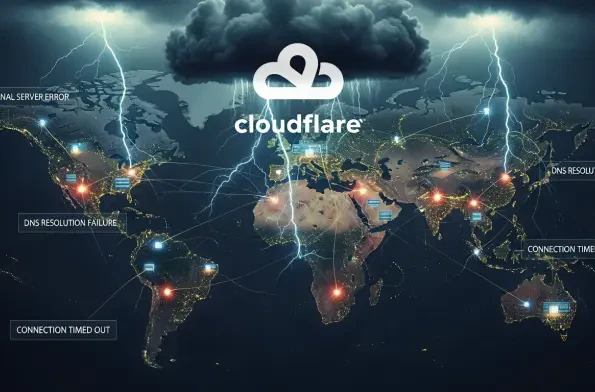In an increasingly interconnected digital landscape, a single glitch can send shockwaves across the globe, disrupting everything from casual browsing to critical public services, and a recent outage at Cloudflare, a San Francisco-based internet infrastructure giant, has underscored this reality with startling clarity. Known for its role as a content delivery network (CDN), Cloudflare supports around 20% of the world’s websites by enhancing speed and security. However, when its systems faltered, the ripple effects were felt worldwide, impacting platforms as diverse as social media, online gaming, and emergency management systems. The issue, resolved by 12:44 p.m. EST on a Tuesday, left engineers vigilant for lingering disruptions. This incident not only highlights the pivotal role of such infrastructure providers but also exposes the fragility of a system reliant on a handful of key players. As digital dependency grows, understanding these vulnerabilities becomes paramount for users and businesses alike.
Widespread Impact on Diverse Platforms
The scale of disruption caused by the Cloudflare outage was staggering, affecting a broad spectrum of services that millions rely on daily. Popular platforms like ChatGPT, the online game “League of Legends,” and the social media site X experienced significant downtime, frustrating users worldwide. Beyond entertainment, the outage struck essential systems, including New Jersey Transit and New York City Emergency Management, hampering access to critical information. Internationally, France’s national railway company, SNCF, reported website issues, disrupting access to schedules and travel updates. Even major businesses such as Shopify, Dropbox, Coinbase, and Moody’s credit rating service were not spared, with Moody’s site displaying error messages redirecting users to Cloudflare for updates. This widespread impact illustrates how deeply embedded such infrastructure is in daily operations across sectors, revealing a dependency that can become a liability when systems fail unexpectedly.
Equally concerning was the sheer diversity of affected entities, spanning from individual consumers to large-scale organizations. The outage did not discriminate, hitting both recreational and professional services with equal force. For instance, financial platforms like Coinbase faced interruptions, potentially affecting transactions and market confidence. Meanwhile, e-commerce giant Shopify struggled with downtime, likely impacting sales and customer trust. Public services, often seen as bastions of reliability, were also compromised, leaving commuters and citizens scrambling for alternatives. This incident serves as a stark reminder of how a single point of failure in internet infrastructure can cascade into a global crisis. It raises pressing questions about the robustness of contingency measures in place for such critical systems and whether enough is being done to prevent or mitigate these far-reaching disruptions in an era of digital reliance.
The Hidden Role of Internet Infrastructure
Behind the scenes of every seamless internet experience lies a complex web of infrastructure, with companies like Cloudflare playing a crucial yet often unnoticed role. As explained by cybersecurity expert Mike Chapple, an IT professor at the University of Notre Dame, Cloudflare acts as an intermediary by mirroring website content across thousands of servers globally. This setup typically boosts speed by delivering content from servers closest to the user while protecting sites from traffic surges and cyber threats. However, when this system encounters a glitch, the result is what Chapple terms a “massive digital gridlock.” The recent outage exposed how dependent the internet is on such intermediaries, as millions of users and businesses found themselves cut off from essential services. This hidden machinery, while efficient under normal conditions, becomes a glaring vulnerability when it falters, disrupting the flow of digital life on an unprecedented scale.
This incident also sheds light on a broader pattern of fragility within the digital ecosystem, as it is not an isolated event but part of a troubling trend. Recent outages at other tech giants, such as Microsoft’s Azure cloud portal issue last month affecting access to Office 365 and Minecraft, and Amazon’s cloud computing disruption in October impacting social media and financial services, paint a concerning picture. These failures, often triggered by seemingly minor errors like configuration mistakes, reveal that even the most robust systems are not immune to breakdowns. The cascading effects of such incidents highlight a critical flaw in the current internet architecture: an over-reliance on a few centralized providers. As these companies underpin a vast array of services, their failures can paralyze entire sectors, urging a reevaluation of how redundancy and resilience are prioritized in the design of global internet infrastructure.
Lessons for a More Resilient Digital Future
Reflecting on the Cloudflare outage, it becomes evident that the internet’s foundation, while innovative, rests on a delicate balance that can tip with a single misstep. The incident affected users across the globe, from casual gamers to emergency responders, demonstrating the pervasive reach of such infrastructure failures. It stood alongside other recent disruptions at major tech firms, pointing to a systemic vulnerability that demands attention. Cloudflare’s team, having resolved the core issue, remained on guard for lingering effects, a testament to the complexity of maintaining stability in a hyper-connected world. This event was a wake-up call, emphasizing the need for diversified infrastructure to avoid single points of failure.
Looking ahead, stakeholders must prioritize actionable strategies to bolster internet resilience. Investing in decentralized systems and robust backup plans could mitigate the impact of future outages. Collaboration among tech giants, governments, and cybersecurity experts is essential to develop frameworks that anticipate and address these risks. Encouraging redundancy in critical services, while costly, may prove invaluable in preventing widespread disruptions. The digital landscape, as this incident revealed, is only as strong as its weakest link, and strengthening those links through innovation and foresight is the path forward to ensure a stable, reliable internet for all users and sectors.













